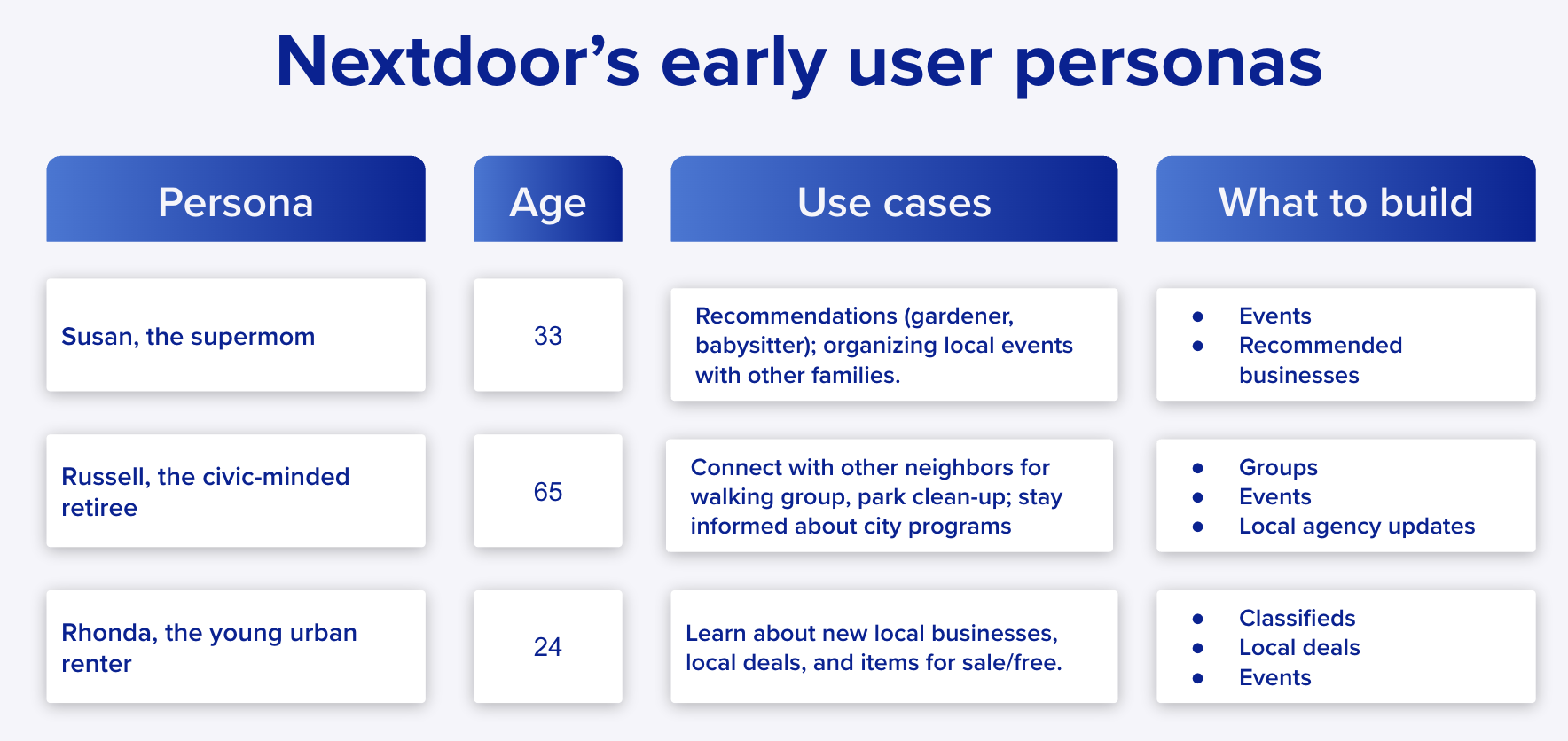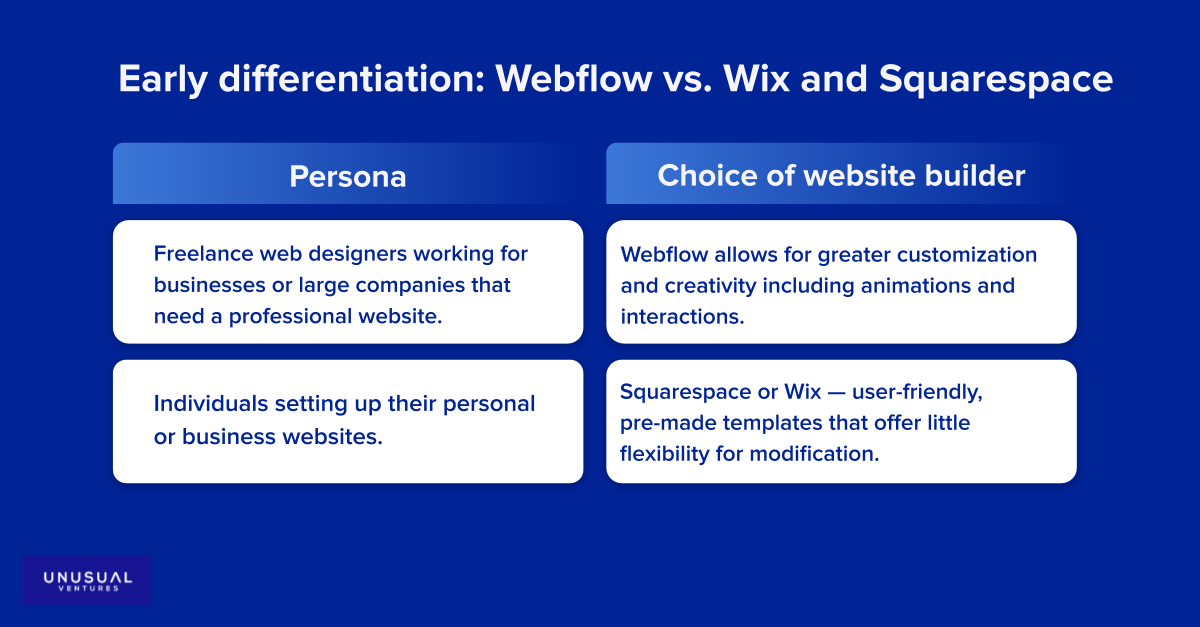

A user persona represents your ideal customer — someone who needs your product enough that they would be willing to pay for it, not just once but repeatedly. While finding a desperate customer is one of the key ingredients to finding product-market fit, it is equally important to not sell to people who will not convert to repeat paying customers — even if it’s tempting to do so to show more market momentum.
B2B businesses should build and validate their Ideal Customer Profile prior to building their product. For consumer companies, it is equally important to engage in user research early to discover the “die-hard” users who will become evangelists for their products before investing significant dollars into customer acquisition.
In this post, we’ll discuss the mistakes founders make while defining their personas; we’ll also provide a playbook for building personas with case studies on Webflow and Nextdoor’s approaches. Their extreme focus on their user personas helped them find product-market fit and build enduring businesses.
Customer discovery is when startups validate their value hypothesis — the what, the who, and the how for your startup:
Validating the value hypothesis can help startups uncover why a specific set of target customers might want to use their product more than anyone else. It is important to find out whether people really want to solve the problem that your product intends to fix. Here’s a tool for consumer companies that are in the process of validating their value hypotheses.
Once you have found “the who”, you’ll need to define user personas to codify the characteristics of your ideal customers. Well-defined user personas offer another way to say: “Here are all of the people that we are NOT going to serve.” Your user persona represents the core enthusiasts that you want to delight and convert into promoters. They will help you design and launch your initial product offering. This group can be small, but they should be influential to a broader audience.
Many marketers are used to defining personas based on externally visible and easy-to-target attributes like job titles (“VP Engineering”) and demographics (“Mid 40s, likely living in cities like X”). While this is useful for large-scale lead generation or ad-targeting, it’s not as useful for early-stage startups because their target users might have diverse needs. Instead, your persona should be fairly detailed and clarify what your target user does. For example, you could start with: Engineering leader with a team of over 30 developers working in a large fintech company. This provides more definition about your ideal target user, as well as attributes that best correlate to the problem you solve.
Some founders try to optimize for multiple personas to expand their market opportunity. However, this is a big mistake. This is especially common among first-time founders who think this is what investors want to see. It is not. It’s much more powerful to have a narrower set of users who love your product versus a broader set of users who kind of like it. Successful companies are built on products that have a diehard group of users who love a product so much that they will tell others about it. Don’t be afraid to narrow your focus and deliver an exceptional product. You can build on that success later. The more specific you can be, the easier it will be to prioritize the product roadmap and ensure the entire team is focused on the same single persona.
If you have found the right user persona, you must live and breathe in their shoes. You should know what they read, where they hang out and what toothpaste they buy! Bring your personas to life for your whole team — give them a real name, photo, and a complete description. Make them visible to everyone on the team. Post them around the office. The detailed personas will help the team align around the customer and make better product tradeoff decisions.
The Webflow team didn’t have to look too far to find their initial ideal user — co-founder Sergie Magdalin served as the perfect proxy for their user base of professional web designers.
Sergie had worked very closely with his brother Vlad on earlier iterations of what would eventually become Webflow. While this had cemented a close working relationship between the two, Vlad (who was a programmer) found the task of translating design into code tedious. As he describes it, “Webflow came out of asking ourselves how we could allow Sergie to use his creativity and automate the implementation work I was doing.” They wanted to “productize” what had historically been a service-based approach to web design work, where a designer had to necessarily partner with a developer/coder and pay them in order to implement their designs.
In 2012, Webflow was entering a fairly crowded market space for website builders. Companies like Wix and Squarespace had already captured a segment of the audience that was interested in creating websites that required no coding. These services were meant for anyone who was interested in quickly building a website from several pre-made templates. However, Webflow differentiated itself from these products by focusing on professional websites that typically required a collaboration between a web designer and a developer. Webflow wanted to position itself as the platform for designers to launch custom professional websites that can work as powerful marketing assets, reach customers, and generate leads for businesses.

Listen as Webflow co-founder and former CTO Bryant Chou explains why their core user persona was key to the company’s success:
Webflow’s core user persona has evolved since its early years, but its laser focus on its initial beachhead — freelance designers — helped the company eventually cross the chasm into enterprise.
To learn more about Webflow’s early days and how the company found product-market fit, check out Bryant Chou’s interview with Sandhya Hegde on the Startup Field Guide podcast.
Nextdoor’s goal was to build a community of users in a neighborhood. As a result, they had multiple personas in their early user journey.
Here’s a look at the personas that Nextdoor created in 2011, a year into the company’s founding:

They wanted to find “Founding Members” in each neighborhood who would become early adopters and evangelists for Nextdoor. These Founding Members would recruit other members, and help Nextdoor organically build up a digital community of neighborhood users. To execute on this idea, Nextdoor’s marketing team went to work testing messaging through surveys, interviews, and digital campaigns. They also collected a lot of information about their Founding Members — the first users to start their own Nextdoor neighborhood and invite their fellow neighbors to join. As part of the product sign-up flow, each Founding Member was required to complete an application about why they wanted to start their own neighborhood. That information helped Nextdoor understand their earliest users and further refine their personas. It was an essential way to align the company’s growing team and be precise about who they were targeting in the early days.
These personas guided the company’s product strategy, helped them build their roadmap, develop marketing messages, prioritize partnerships, and optimize sign-up flows. Most importantly, it empowered everyone in the company to prioritize and say no to work that didn’t directly help their selected personas be successful on Nextdoor.
In the following, Sarah Leary, Nextdoor’s co-founder, explains the rigorous user testing and segmentation process that helped the company narrow down its user base.
To learn more about Nextdoor’s early days and how the company found product-market fit, check out Sarah Leary’s interview with Sandhya Hegde on the Startup Field Guide podcast.
If you are in the process of defining your user personas, complete this persona exercise. The sooner you do this exercise, the sooner you and your team will be on the same page about who you are serving.
For more insights and updates on finding product-market fit, subscribe to our newsletter!